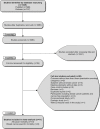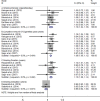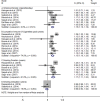Smoking increases risks of all-cause and breast cancer specific mortality in breast cancer individuals: a dose-response meta-analysis of prospective cohort studies involving 39725 breast cancer cases
- PMID: 27863414
- PMCID: PMC5347758
- DOI: 10.18632/oncotarget.13366
Smoking increases risks of all-cause and breast cancer specific mortality in breast cancer individuals: a dose-response meta-analysis of prospective cohort studies involving 39725 breast cancer cases
Abstract
Smoking is associated with the risks of mortality from breast cancer (BC) or all causes in BC survivors. Two-stage dose-response meta-analysis was conducted. A search of PubMed and Embase was performed, and a random-effect model was used to yield summary hazard ratios (HRs). Eleven prospective cohort studies were included. The summary HR per 10 cigarettes/day, 10 pack-years, 10 years increase were 1.10 (95% confidence interval (CI) = 1.04-1.16), 1.09 (95% CI = 1.06-1.12), 1.10 (95% CI = 1.06-1.14) for BC specific mortality, and 1.15 (95% CI = 1.10-1.19), 1.15 (95% CI = 1.10-1.20), 1.17 (95% CI = 1.11-1.23) for all-cause mortality, respectively. The linear or non-linear associations between smoking and risks of mortality from BC or all causes were revealed. Subgroup analyses suggested a positive association between ever or former smoking and the risk of all-cause mortality in BC patients, especially in high doses consumption. In conclusion, higher smoking intensity, more cumulative amount of cigarettes consumption and longer time for smoking is associated with elevated risk of mortality from BC and all causes in BC individuals. The results regarding smoking cessation and "ever or former" smokers should be treated with caution due to limited studies.
Keywords: all-cause mortality; breast cancer specific mortality; breast cancer survival; dose-response; smoking.
Conflict of interest statement
The authors declare that there are no conflicts of interest.
Figures





References
-
- Siegel RL, Miller KD, Jemal A. Cancer statistics, 2016. CA Cancer J Clin. 2016;66:7–30. - PubMed
-
- Ferlay J, Soerjomataram I, Dikshit R, Eser S, Mathers C, Rebelo M, Parkin DM, Forman D, Bray F. Cancer incidence and mortality worldwide: sources, methods and major patterns in GLOBOCAN 2012. Int J Cancer. 2015;136:E359–386. - PubMed
-
- DeSantis CE, Fedewa SA, Goding Sauer A, Kramer JL, Smith RA, Jemal A. Breast cancer statistics, 2015: Convergence of incidence rates between black and white women. CA Cancer J Clin. 2016;66:31–42. - PubMed
-
- DeSantis CE, Lin CC, Mariotto AB, Siegel RL, Stein KD, Kramer JL, Alteri R, Robbins AS, Jemal A. Cancer treatment and survivorship statistics, 2014. CA Cancer J Clin. 2014;64:252–271. - PubMed
Publication types
MeSH terms
LinkOut - more resources
Full Text Sources
Other Literature Sources
Medical

